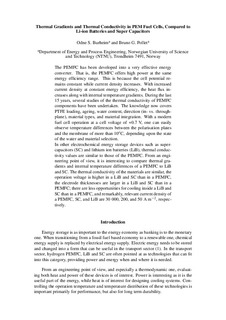Thermal Gradients and Thermal Conductivity in PEM Fuel Cells, Compared to Li-Ion Batteries and Super Capacitors
Journal article, Peer reviewed
Accepted version

Åpne
Permanent lenke
http://hdl.handle.net/11250/2609799Utgivelsesdato
2018Metadata
Vis full innførselSamlinger
Sammendrag
The PEMFC has been developed into a very effective energy converter. That is, the PEMFC offers high power at the same energy efficiency range. This is because the cell potential remains constant while current density increases. With increased current density at constant energy efficiency, the heat flux increases along with internal temperature gradients. During the last 15 years, several studies of the thermal conductivity of PEMFC components have been undertaken. The knowledge now covers PTFE loading, ageing, water content, direction (in- vs. through-plane), material types, and material integration. With a modern fuel cell operation at a cell voltage of +0.7 V, one can easily observe temperature differences between the polarisation plates and the membrane of more than 10°C, depending upon the state of the water and material selection. In other electrochemical energy storage devices such as supercapacitors (SC) and lithium ion batteries (LiB), thermal conductivity values are similar to those of the PEMFC. From an engineering point of view, it is interesting to compare thermal gradients and internal temperature differences of a PEMFC to LiB and SC. The thermal conductivity of the materials are similar, the operation voltage is higher in a LiB and SC than in a PEMFC, the electrode thicknesses are larger in a LiB and SC than in a PEMFC; there are less opportunities for cooling inside a LiB and SC than in a PEMFC, and remarkably, relevant current density of a PEMFC, SC, and LiB are 30 000, 200, and 50 A m-2, respectively.